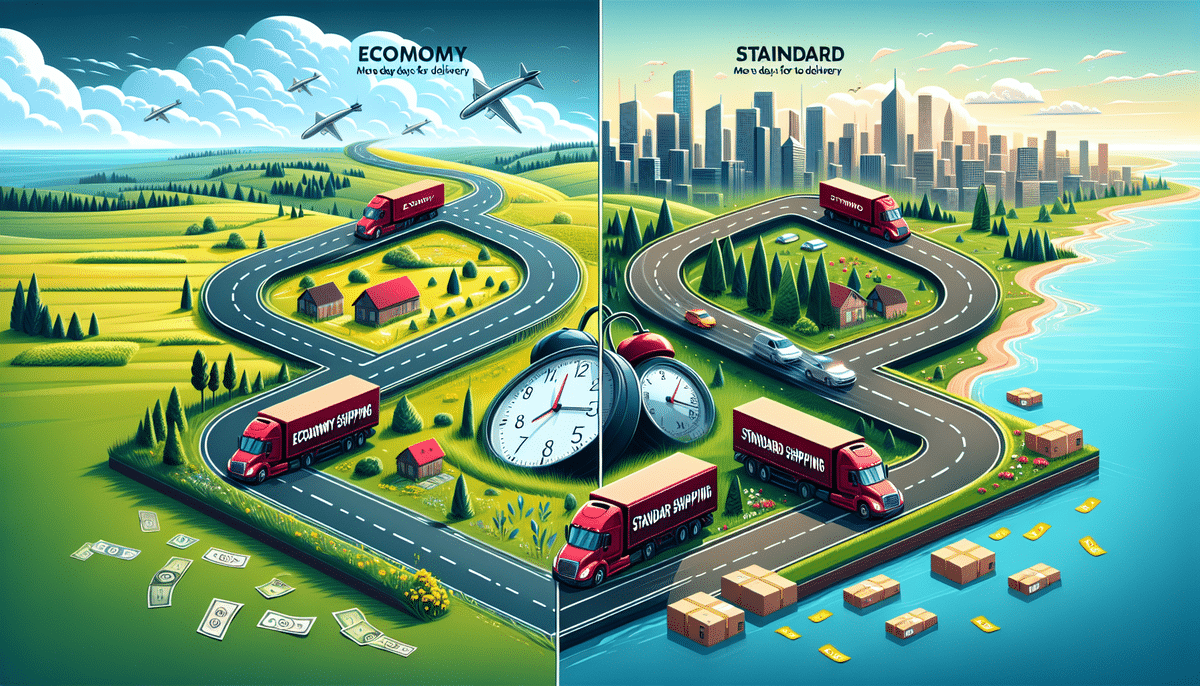Comparing Economy and Standard Shipping: Which Option is Best for Your Business?
When shipping products for your business, several factors must be considered. One of the most critical decisions is choosing between economy and standard shipping. This article delves into the fundamentals of both options, examines delivery timelines and costs, and outlines the pros and cons of each to help you make an informed decision.
The Basics of Economy and Standard Shipping
Understanding the differences between economy and standard shipping is essential before making a decision. Economy shipping is the most affordable option but typically involves slower delivery times, often utilizing ground transportation. In contrast, standard shipping is faster and more expensive, usually involving air transportation.
Eligibility and Special Handling
Not all items qualify for economy shipping. Products that require special handling or expedited delivery due to their fragility or value may only be eligible for standard shipping. Additionally, some retailers offer free standard shipping on orders exceeding a certain amount, making it a cost-effective choice for larger purchases.
Cost and Delivery Timeline for Economy Shipping
If budget is a primary concern and longer delivery times are acceptable, economy shipping may be ideal. Typically, economy shipping costs less than standard shipping and has a delivery timeline of 5 to 10 business days. However, this timeline can vary based on factors such as distance, product type, and transportation mode.
Cost-Benefit Analysis
While economy shipping offers cost savings, it may not be suitable for all products. Fragile or perishable items might require faster shipping to ensure they arrive in good condition. Additionally, some customers prefer paying more for quicker delivery, so providing multiple shipping options can enhance customer satisfaction.
Pros and Cons of Economy Shipping
Advantages
- Lower shipping costs, beneficial for large or heavy items
- Cost savings for businesses with high shipping volumes
- Potential to offer free standard shipping on larger orders
Disadvantages
- Longer delivery times may frustrate customers
- Not ideal for fragile or time-sensitive products
- Potential impact on customer satisfaction if delivery is too slow
Cost and Delivery Timeline for Standard Shipping
Standard shipping is preferred when speed and reliability are paramount. It generally costs more than economy shipping but offers faster delivery, typically within 3 to 5 business days. The cost varies based on package weight, size, and carrier rates.
Tracking and Reliability
Standard shipping often includes tracking information, allowing businesses and customers to monitor the shipment's progress. This feature enhances reliability and can improve customer satisfaction by providing transparency.
Benefits and Drawbacks of Standard Shipping
Advantages
- Faster delivery times meet customer expectations
- Increased reliability with tracking options
- Suitable for time-sensitive and high-value products
Disadvantages
- Higher shipping costs can impact profit margins
- May not be available for all destinations, especially remote areas
- Cost can escalate for large or heavy items
Deciding Between Economy and Standard Shipping
Choosing the right shipping option requires evaluating your business needs and customer expectations. Consider factors such as product size and weight, delivery speed requirements, destination, and budget constraints. Offering both shipping options can cater to a broader range of customer preferences.
International Shipping Considerations
When shipping internationally, the choice becomes more complex. Economy shipping is cost-effective but slower, while standard shipping is faster but more expensive. Additionally, international shipments may incur customs or import fees, which should be factored into your decision.
Maximizing Savings with Economy Shipping
If you opt for economy shipping, implement strategies to maximize savings:
- Bundle Shipments: Combine multiple products into a single shipment to reduce costs.
- Compare Carriers: Shop around and compare shipping rates from different carriers.
- Use Shipping Calculators: Estimate shipping costs beforehand to make informed decisions.
Ensuring Smooth Deliveries with Standard Shipping
To ensure smooth deliveries when using standard shipping:
- Proper Labeling: Accurately label packages to prevent delays or losses.
- Tracking Systems: Utilize tracking to monitor shipments and address issues promptly.
- Customer Communication: Keep customers informed about their shipment status to manage expectations.
Evaluating Your Business Needs
Assessing your business requirements is crucial in deciding between economy and standard shipping. Consider your budget, product dimensions, customer preferences, and whether speed or cost savings is more critical. Balancing these factors will help you choose the most suitable shipping method for your business.
Case Studies: Businesses Choosing Economy vs. Standard Shipping
Examining real-life examples can provide valuable insights:
- Business A: Opted for economy shipping to save costs on bulky items, resulting in increased profit margins.
- Business B: Chose standard shipping to meet customer expectations for fast delivery, enhancing customer satisfaction and loyalty.
These case studies highlight the importance of aligning shipping choices with business goals and customer needs.
Managing Customer Expectations
Effective communication is key to managing customer expectations regardless of the shipping option chosen:
- Transparent Information: Clearly communicate delivery timelines and potential delays.
- Multiple Options: Offer various shipping methods to give customers control over their delivery preferences.
By managing expectations, businesses can maintain high levels of customer satisfaction and reduce the likelihood of negative feedback.
In conclusion, the decision between economy and standard shipping is pivotal for any business that ships products. Economy shipping offers cost savings, making it ideal for budget-conscious businesses, while standard shipping provides speed and reliability, meeting the demands of customers who prioritize quick delivery. By evaluating your specific business needs and understanding the implications of each shipping option, you can choose the best method to enhance your business operations and customer satisfaction.




















